HONDA FG100 User Manual
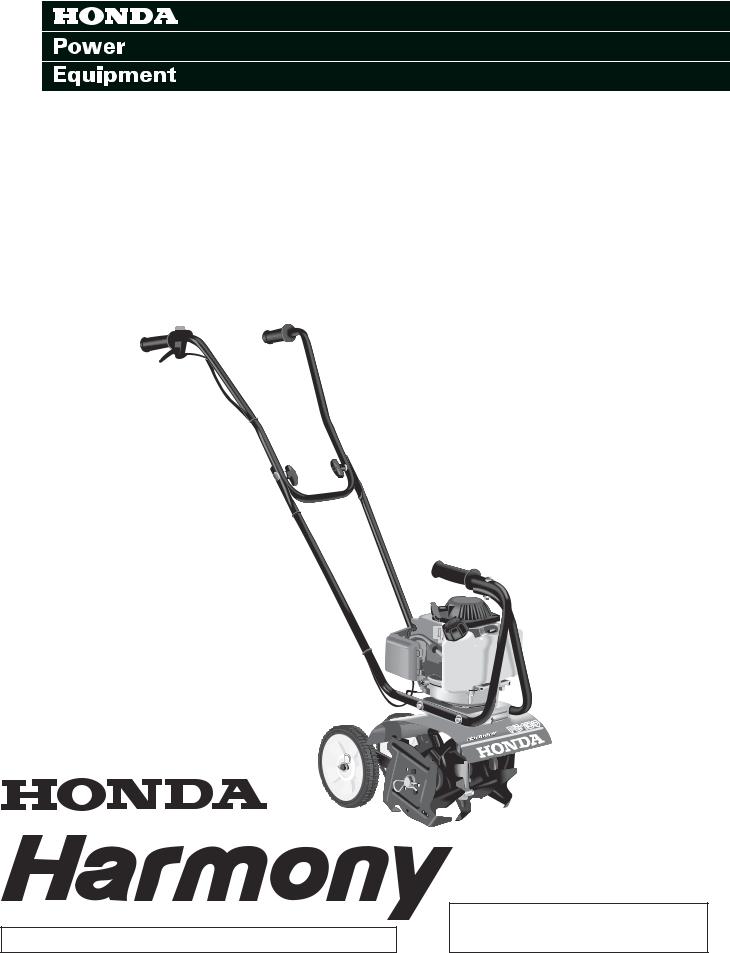
OWNER'S MANUAL
Mini-Tiller
FG100
¿Necesita un manual en Español? Vea a la página 44.
See page 28 for instructions on assembling your FG100 Mini-Tiller.
©1997 American Honda Motor Co., Inc. All Rights Reserved

WARNING:
The engine exhaust from this product contains chemicals known to the State of California to cause cancer, birth defects, or other reproductive harm.
Keep this owner’s manual handy so you can refer to it at any time. This should remain with the tiller if resold.
The information and specifications included in this publication were in effect at the time of approval for printing. American Honda Motor Co., Inc. reserves the right, however, to discontinue or change specifications or design at any time without notice and without incurring any obligation whatever. No part of this publication may be reproduced without written permission.

FG100 TILLER
INTRODUCTION
Congratulations on your selection of a Honda Harmony FG100 Tiller. We are certain you will be pleased with your purchase of one of the finest tillers on the market.
We want to help you get the best results from your new tiller and to operate it safely. This manual contains the information on how to do that; please it carefully.
As you read this manual, you will find information preceded by a |
NOTICE |
symbol. That information |
|
|
|
is intended to help you avoid damage to your tiller, other property, or environment. |
||
We suggest you read the warranty policy to fully understand its coverage and your responsibilities of ownership.
When your tiller needs scheduled maintenance, keep in mind that your Honda servicing dealer is specially trained in servicing Honda tillers. Your Honda servicing dealer is dedicated to your satisfaction and will be pleased to answer your questions and concerns.
Left and right sides of this unit are determined from the operator’s position, standing behind the tiller handlebars, facing the direction of forward travel.
Best Wishes,
Power Equipment Division
American Honda Motor Co., Inc.
1

FG100 TILLER
A FEW WORDS ABOUT SAFETY
Your safety and the safety of others are very important. And using this tiller is an important responsibility.
To help you make informed decisions about safety, we have provided operating procedures and other information on labels in this manual. This information alerts you to potential hazards that could hurt you or others.
Of course, it is not practical or possible to warn you about all the hazards associated with operating or maintaining a tiller. You must use your own good judgment.
You will find important safety information in a variety of forms, including:
•Safety Labels - on the tiller
•Safety Messages - preceded by a safety alert symbol and of the following three words; DANGER, WARNING, or CAUTION.
These signal words mean:
DANGER
WARNING
You WILL be Killed or SERIOUSLY HURT if you don’t follow instructions.
You CAN be KILLED or SERIOUSLY HURT if you don’t follow instructions.
CAUTION You CAN BE HURT if you don’t follow instructions.
•Safety Headings - such as IMPORTANT SAFETY INFORMATION.
•Safety Section - such as TILLER SAFETY.
•Instructions - how to use this tiller correctly and safely.
This entire book is filled with important safety information - please read it carefully.
2

FG100 TILLER
CONTENTS |
|
SAFETY ............................................................ |
4 |
IMPORTANT SAFETY INFORMATION......... |
4 |
ATTACHMENTS AND MODIFICATIONS ...... |
5 |
IMPORTANT MESSAGE TO EMPLOYERS.. |
5 |
IMPORTANT MESSAGE TO PARENTS ....... |
5 |
SAFETY LABEL LOCATIONS ....................... |
6 |
CONTROLS ...................................................... |
7 |
COMPONENT IDENTIFICATION .................. |
7 |
DESCRIPTION OF CONTROLS.................... |
8 |
Throttle Lever . . . . . . . . . . . . . |
8 |
Engine Switch . . . . . . . . . . . . . |
8 |
Handle Bar Adjustment . . . . . . . . . . |
8 |
Choke Lever . . . . . . . . . . . . . . |
8 |
Priming Bulb . . . . . . . . . . . . . . |
8 |
Transport Wheels . . . . . . . . . . . . |
9 |
Carrying Handle . . . . . . . . . . . . |
9 |
Recoil Starter Grip . . . . . . . . . . . |
9 |
Drag Bar . . . . . . . . . . . . . . . |
9 |
BEFORE OPERATION ..................................... |
10 |
GENERAL...................................................... |
10 |
CHECK TILLING AREA ................................. |
11 |
CHECK TILLER ............................................. |
11 |
OPERATION..................................................... |
12 |
SAFETY PRECAUTIONS .............................. |
12 |
MOVING THE TILLER ................................... |
12 |
HANDLEBAR ADJUSTMENT ........................ |
12 |
STARTING/STOPPING THE ENGINE .......... |
13 |
TILLER OPERATION..................................... |
14 |
MAINTENANCE & ADJUSTMENTS ................. |
17 |
THE IMPORTANCE OF MAINTENANCE...... |
17 |
MAINTENANCE SAFETY .............................. |
17 |
MAINTENANCE SCHEDULE ........................ |
18 |
Engine Oil . . . . . . . . . . . . . . . |
19 |
Air Filter . . . . . . . . . . . . . . . |
20 |
Spark Plug . . . . . . . . . . . . . . |
22 |
Spark Arrester . . . . . . . . . . . . . |
23 |
Cooling Fins . . . . . . . . . . . . . . |
24 |
Throttle Cable . . . . . . . . . . . . . |
24 |
Idle Speed . . . . . . . . . . . . . . . |
24 |
Fuel System . . . . . . . . . . . . . . |
25 |
Transmission . . . . . . . . . . . . . |
27 |
ASSEMBLY ...................................................... |
|
28 |
THE IMPORTANCE OF ASSEMBLY ............ |
28 |
|
UNPACKING ................................................. |
|
29 |
LOOSE PARTS ............................................. |
|
29 |
TILLER ASSEMBLY ...................................... |
|
30 |
TRANSPORTING/STORAGE........................... |
|
34 |
TRANSPORTING .......................................... |
|
34 |
STORAGE ..................................................... |
|
34 |
TAKING CARE OF UNEXPECTED |
|
|
PROBLEMS...................................................... |
|
37 |
STARTING PROBLEMS................................ |
|
37 |
ENGINE OPERATING PROBLEMS .............. |
|
37 |
SPECIFICATIONS............................................ |
|
38 |
TECHNICAL & CONSUMER |
|
|
INFORMATION................................................. |
|
39 |
SERIAL NUMBER LOCATIONS.................... |
|
39 |
HONDA PUBLICATIONS .............................. |
|
39 |
OPTIONS....................................................... |
|
39 |
WARRANTY .................................................. |
|
40 |
EMISSION CONTROL |
|
|
SYSTEM WARRANTY .................................. |
|
42 |
WARRANTY SERVICE INFORMATION ....... |
44 |
|
OXYGENATED FUELS ................................. |
|
45 |
HIGH ALTITUDE OPERATION ..................... |
|
45 |
EMISSION CONTROL |
|
|
SYSTEM INFORMATION.............................. |
|
46 |
QUICK REFERENCE.......................... |
Back Cover |
|
Maintenance..................................... |
Back Cover |
|
Tuneup.............................................. |
Back Cover |
|
3

SAFETY
IMPORTANT SAFETY INFORMATION
Most accidents with this product can be prevented if you follow all instructions in this manual and on the product. The most common hazards, according to accident statistics, are discussed below, along with the best way to protect yourself and others.
Honda Tiller Usage
Honda tillers are designed to give safe and dependable service if operated according to instructions and intended use.
Honda tillers are intended to be used by an experienced, trained, operator who is familiar with the use of power equipment. Do not allow a child or an inexperienced, untrained operator to use this tiller. Operating this equipment requires special effort on your part to ensure your safety and the safety of others. Read and understand this owner’s manual.
Avoid Rotating Tines
The rotating tines can cause injury. Keep away from the tine shield whenever the engine is running. If you need to adjust the tines, or work around the tines for any reason, always stop the engine. Disconnect the spark plug cap if you need to clean or handle the tines.
Clear Tilling Area
The tiller tines can throw rocks and other objects with enough force to cause injury. Before tilling, carefully inspect the area and remove all large debris.
Keep Shields in Place
Guards and shields are designed to protect you from being hit by thrown objects and from hot engine parts and moving components. For your safety and the safety of others, keep all shields in place when operating the tiller.
Refuel with Care
Gasoline is extremely flammable and gasoline vapor can explode. Refuel only outdoors, in a well-ventilated area, with the engine off. Never smoke near gasoline, and keep other flames and sparks away. Always store gasoline in an approved container.
Wear Protective Clothing
Wearing protective clothing will reduce your risk of injury. Long pants and eye protection reduce the risk of injuries from thrown objects. Sturdy shoes with aggressive soles will help protect your feet and give you better traction on slopes or uneven ground. Clothing worn by the operator should be fairly tight and belted. Loose clothing should not be permitted because of the danger of getting into moving parts. Tie up or restrain long hair.
Turn Engine Off When Not Tilling
If you need to leave the tiller for any reason, even just to inspect the area ahead, always stop the engine .
4 |
FG100 TILLER |

SAFETY
ATTACHMENTS AND MODIFICATIONS
Do not make any modifications to your tiller. Modifying your tiller, or installing non-Honda attachments, can make your tiller unsafe.
If you need attachments for your tiller, use only genuine Honda attachments. These products have been designed for your tiller and are covered by warranty.
Non-Honda attachments are usually designed for universal applications. Although aftermarket attachments may fit on your tiller, they may not meet factory specifications and could make your tiller unsafe.
IMPORTANT MESSAGE TO EMPLOYERS
As an employer, you have special responsibilities to the people who work for you.
Before you ask anyone to operate this tiller, you need to determine whether the person is old enough, large enough, and strong enough to safely handle and control the tiller.
If you decide they are, make sure the employee reads and understands all instructions and warnings in this manual, and on the labels before operating the tiller.
Allow adequate time for hands-on training by a qualified instructor, and personally supervise practice sessions until you feel sure the employee is ready to operate the tiller.
Also be sure employees wear proper clothing and have eye protection and any other gear that may be required by local ordinances or your insurance company.
Remember, too, that you are responsible for keeping the tiller properly maintained and in safe operating condition.
Your commitment to safety on the job can help prevent accidents and result in longer and more productive years of service.
IMPORTANT MESSAGE TO PARENTS
Your child’s safety is very important to Honda. Read this message if you decide to permit your youngster to operate this tiller. Tillers are tools, not toys. As with any equipment, bad judgments can result in serious injuries. You can prevent accidents by making good decisions about if, when, and how your youngster operates this equipment.
The first question you’ll need to ask is whether your youngster is capable of operating this tiller safely. Remember, young people vary widely, and AGE IS NOT THE ONLY FACTOR. Physically, a youngster must be LARGE ENOUGH AND STRONG ENOUGH to easily start the tiller and control its direction. The youngster also needs enough size, strength, and coordination to comfortably reach and operate the controls.
Another, tougher question you need to ask is if your youngster has enough MATURITY AND RESPONSIBILITY to safely operate this tiller. Does the young person think through problems and come to logical solutions? Be honest! Anyone who takes unnecessary risks and doesn’t obey rules should not operate this tiller.
If you decide that your son or daughter can handle the tiller safely, carefully read the owner’s manual with your youngster. Make sure you both understand all instructions and safety information. Also, be sure your youngster wears sturdy shoes and other protective clothing when operating or handling the tiller.
SUPERVISION is important. Walk behind your youngster during the first few minutes of tilling. Even after the youngster is confident, do not let them use the tiller without supervision. An adult should also be present during refueling and maintenance. Be sure the tiller is properly maintained and kept in safe operating condition.
By always placing safety first, your youngster will acquire useful skills and a sense of accomplishment, and you’ll both get the best results from your tiller.
FG100 TILLER |
5 |
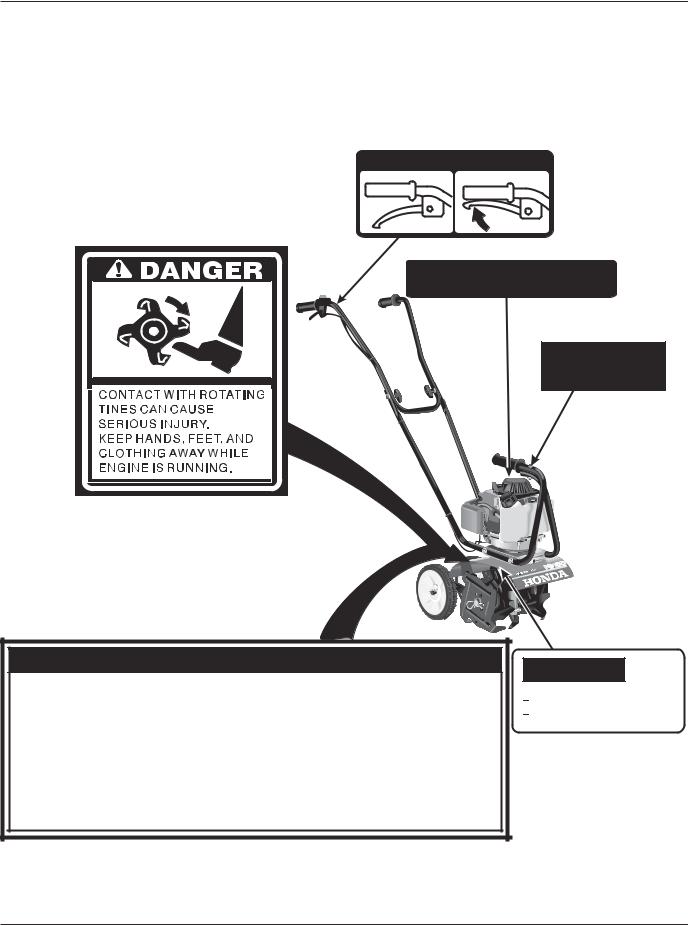
SAFETY
SAFETY LABEL LOCATIONS
The labels shown here contain important safety information. Please read them carefully. These labels are considered permanent parts of your Honda tiller. If a label comes off or becomes hard to read, immediately contact a Honda tiller servicing dealer for a replacement label.
DISENGAGE ENGAGE
 HOT / CHAUD
HOT / CHAUD
 HOLD HERE WHEN STARTING
HOLD HERE WHEN STARTING
CONTACT WITH ROTATING TINES CAN CAUSE
SERIOUS INJURY. KEEP HANDS, FEET AND
CLOTHING AWAY WHILE ENGINE IS RUNNING.
 WARNING
WARNING
TO AVOID SERIOUS INJURY
READ THE OWNER'S MANUAL CAREFULLY BEFORE OPERATION.
KNOW LOCATION AND FUNCTIONS OF ALL CONTROLS.
KEEP ALL SAFETY DEVICES AND SHIELDS IN PLACE AND WORKING.
NEVER ALLOW CHILDREN OR UNINSTRUCTED ADULTS TO OPERATE MACHINE.
SHUT OFF ENGINE BEFORE MANUALLY UNCLOGGING TINES OR MAKING REPAIRS.
KEEP BYSTANDERS AWAY FROM MACHINE.
KEEP AWAY FROM ROTATING PARTS WHILE ENGINE IS RUNNING.
USE EXTREME CAUTION WHEN REVERSING OR PULLING THE MACHINE TOWARDS YOU.
NOTICE
To avoid damaging engine: 
 Check oil before operation.
Check oil before operation.

 Do not use gas/oil mix.
Do not use gas/oil mix.
6 |
FG100 TILLER |
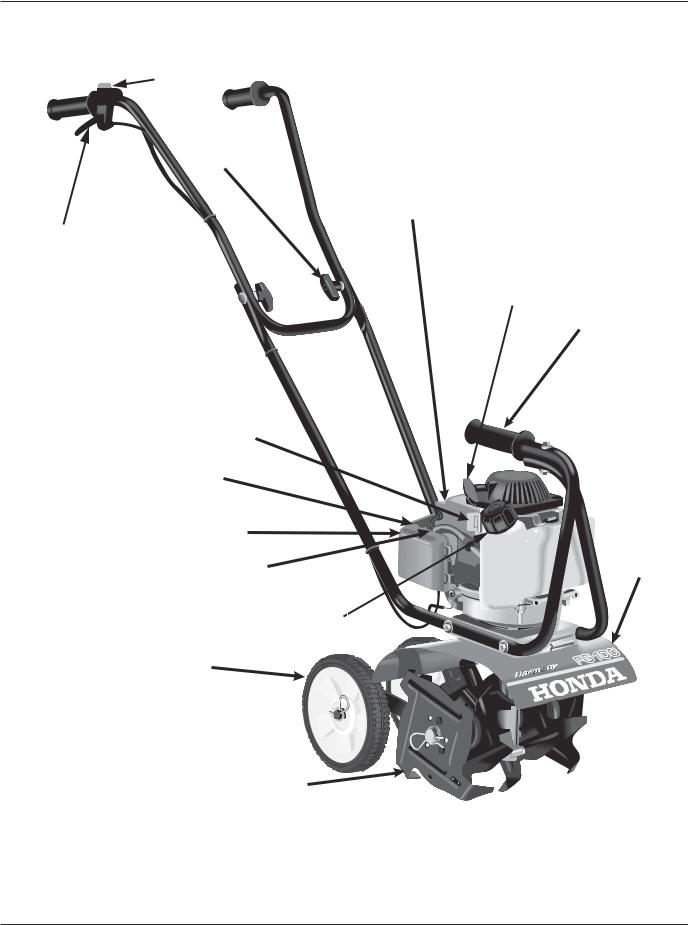
CONTROLS
COMPONENT IDENTIFICATION
ENGINE
SWITCH
HANDLE
HEIGHT
ADJUSTER
SPARK PLUG
THROTTLE LEVER
ENGINE OIL FILLER CAP/
ENGINE OIL DRAIN
CHOKE LEVER
AIR CLEANER
PRIMING BULB
FUEL CAP
TRANSPORT WHEEL
OR DRAG BAR
TILLING TINES
RECOIL STARTER
CARRYING HANDLE
TINE
SHIELD
FG100 TILLER |
7 |
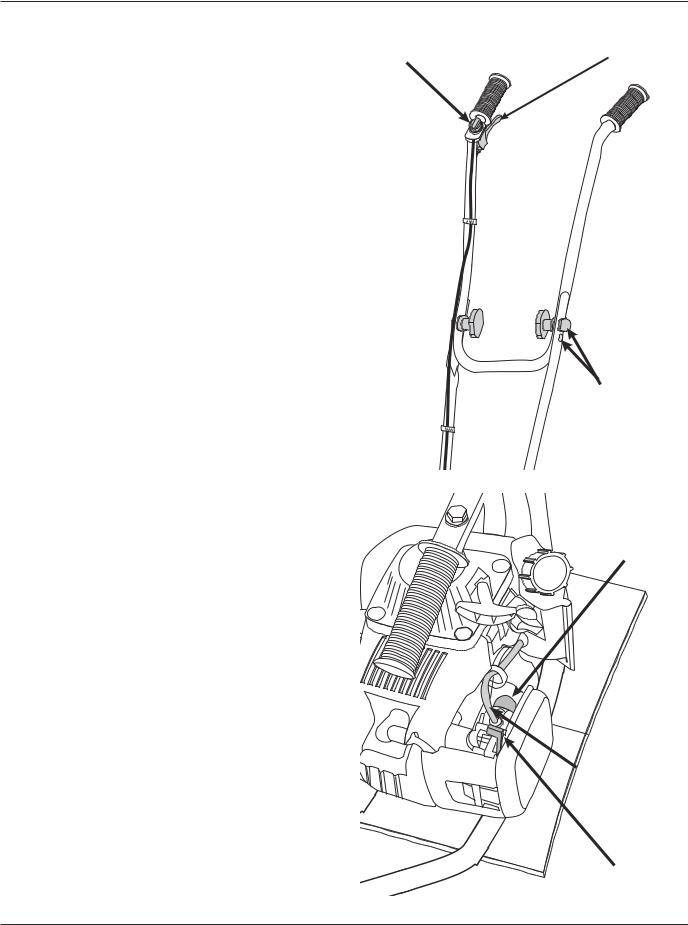
CONTROLS
DESCRIPTION OF CONTROLS
Throttle Lever
The throttle lever controls engine speed and tiller tine rotation.
Pulling the throttle lever towards the grip increases the engine speed which causes the tines to turn. Releasing the throttle lever reduces engine speed and stops the tiller tines from turning.
The tiller will have the greatest tilling force at maximum engine speed. At idle, the tilling tines should stop rotating.
Engine Switch
The engine switch controls the ignition system.
The engine switch must be in the ON position for the engine to start and run. Moving the engine switch to the OFF position stops the engine.
Handle Bar Adjustment
There are two positions that the handlebars can be adjusted to best suit the height of the operator.
Choke Lever
The choke lever opens and closes the choke valve in the carburetor.
The CLOSED position enriches the fuel mixture for starting a cold engine. The OPEN position provides the correct fuel mixture for operation after starting, and for restarting a warm engine.
Priming Bulb
Pressing the priming bulb pumps fuel from the fuel tank to the carburetor. This procedure is necessary for starting a cold engine and after refueling an engine that has run out of fuel.
To ensure that fuel has reached the carburetor, press the priming bulb repeatedly until fuel can be seen in the clear-plastic fuel-return tube.
ENGINE SWITCH |
THROTTLE LEVER |
|
HANDLE BAR ADJUSTMENT (2-positions)
PRIMER
BULB
FUEL-RETURN TUBE (clear plastic)
CHOKE LEVER
8 |
FG100 TILLER |
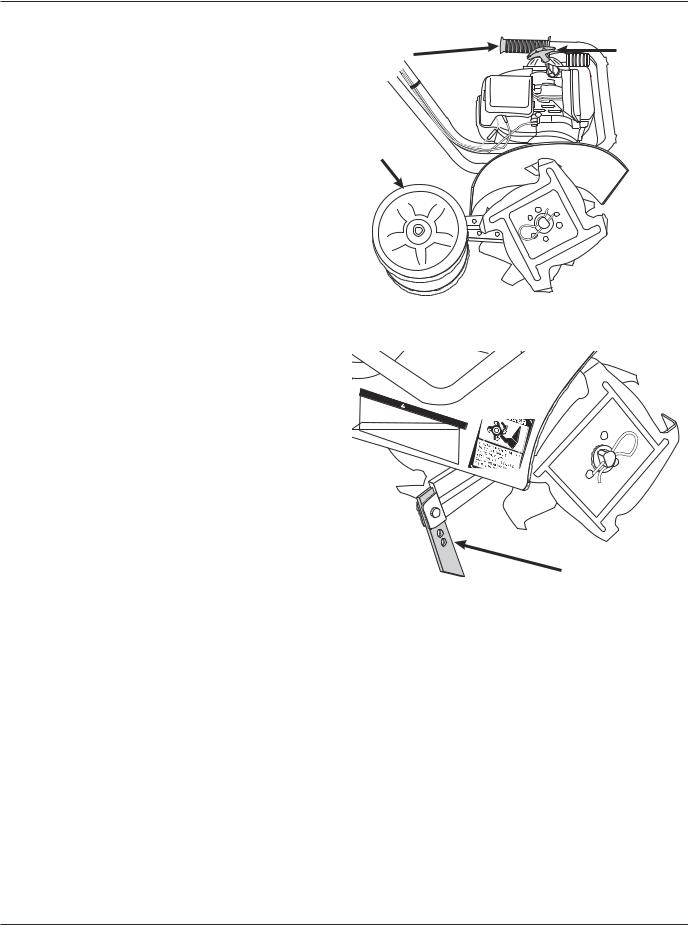
CONTROLS
Transport Wheels
The transport wheels are used to move the tiller around. Before tilling, the transport wheels must be removed and the drag bar installed in their place.
Carrying Handle
The carrying handle rubber grip is used to hold the tiller when starting the engine.
The carrying handle can be used to load/unload the tiller, and to assist in certain engine maintenance procedures.
Recoil Starter Grip
Pulling the starter grip operates the recoil starter to crank the engine for starting.
CARRYING |
RECOIL |
|
HANDLE |
||
STARTER |
||
|
||
TRANSPORT |
|
|
WHEELS |
|
Drag Bar
The drag bar is used to control the forward action of the turning tiller tines. The drag bar can be adjusted to control the tilling depth of the tines.
|
|
|
|
|
• |
READ |
|
|
|
|
|
|
|
|
|
|
|
|
|
|
|
|
|||
|
|
|
|
• |
• KNOW THE |
OWNER'S |
|
TO |
AVOID WARNING |
|
|
|
|
|
|
||||||||||
|
|
|
• |
KEEP |
|
|
|
|
|
|
|
|
|
||||||||||||
|
|
|
|
|
|
|
|
ALLLOCATION |
|
|
|
|
|
|
|
|
|||||||||
|
|
• |
• |
|
NEVER |
|
SAFETYAND MANUAL |
SERIOUS |
|
|
|
|
|
|
|
||||||||||
|
|
|
SHUT |
|
ALLOW |
|
|
|
|
|
|
|
|
|
|
|
|
||||||||
|
|
|
KEEP |
OFF |
|
|
|
FUNCTIONSCAREFULLY |
|
|
|
|
|
|
|
|
|||||||||
• |
• |
|
KEEP |
|
|
|
ENGINECHILDREN |
|
AND |
ALL |
|
INJURY |
|
|
|
|
|||||||||
|
|
|
|
|
|
|
|
|
OR |
|
|
BEFORE |
|
|
|
|
|
||||||||
|
|
USE |
|
AWAYBYSTANDERSBEFORE |
|
|
SHIELDS CONTROLSOPERATION. |
. |
|
||||||||||||||||
YOU. |
EXTREME |
|
AWAY |
FROMMANUALLYUNINSTRUCTED |
PLACE |
AND |
|
|
|
|
|||||||||||||||
|
|
|
|
FROM |
|
|
|
|
|
|
|
|
|
|
|||||||||||
|
|
|
|
|
|
|
|
|
|
|
CAUTIONROTATING |
|
|
|
ADULTS |
TOWORKING. |
|
||||||||
|
|
|
|
|
|
|
|
|
|
|
|
WHENPARTSMACHINEUNCLOGGING. |
|
|
|||||||||||
|
|
|
|
|
|
|
|
|
|
|
|
|
|
|
|
|
WHILE |
|
|
TINESOPERATE |
|
||||
|
|
|
|
|
|
|
|
|
|
|
|
|
|
|
REVERSING ENGINE |
IS |
|
|
OR |
MAKINGMACHINE. |
|||||
|
|
|
|
|
|
|
|
|
|
|
|
|
|
|
|
|
OR |
|
|
|
|
||||
|
|
|
|
|
|
|
|
|
|
|
|
|
|
|
|
|
|
PULLINGRUNNING. |
|
|
REPAIRS. |
||||
|
|
|
|
|
|
|
|
|
|
|
|
|
|
|
|
|
|
|
|
|
THE |
MACHINE |
|||
|
|
|
|
|
|
|
|
|
|
|
|
|
|
|
|
|
|
|
|
|
|
TOWARDS |
|||
|
|
|
|
|
|
|
|
|
|
|
|
|
|
|
|
|
|
|
|
|
|
|
|
|
|
DRAG BAR
FG100 TILLER |
9 |

BEFORE OPERATION
ARE YOU READY TO OPERATE THE TILLER?
Your safety is your responsibility. A little time spent in preparation will significantly reduce your risk of injury.
Knowledge
Read and understand this manual. Know what the controls do and how to operate them.
Familiarize yourself with the tiller and its operation before you begin to use it. Know what to do in case of emergencies.
Physical and Mental Readiness
You must be alert and in good physical condition to operate the tiller. Do not operate the tiller if you are tired, ill, or under the influence of alcohol, medication, or any substance that might impair your vision, dexterity, or judgment.
If you have any physical problem that may be aggravated by strenuous work, consult your physician before operating the tiller.
Protective Clothing
Wearing protective clothing will reduce your risk of injury. Do not wear loose clothing, jewelry, short pants, sandals, or go barefoot. Secure hair so it is above shoulder level.
Eye, Face, and Head Protection
Always wear safety glasses or goggles that comply with ANSI standard Z87.1 to protect your eyes from thrown objects. Prescription glasses may be worn under the safety glasses or goggles.
Wearing a dust mask will help to reduce the amount of pollens and dust inhaled.
Hearing Protection
Hearing protectors will help to protect your ears from noise. Earmuff-style hearing protectors can also protect your ears from thrown objects.
Hand and Body Protection
Wear gloves, a long-sleeved shirt, and long pants made of heavy material. Clothing should fit closely but allow freedom of movement, and should have no strings, straps, etc. that could catch on brush or the tiller. Keep clothing fastened.
Foot Protection
Wear sturdy work boots with good toe protection and nonslip soles.
10 |
FG100 TILLER |

BEFORE OPERATION
IS YOUR WORKING AREA READY?
Objects thrown by the tiller can cause serious injury. Be especially careful when crossing gravel drives, walks or roads. Before operating the tiller, carefully inspect the area, and remove all objects that could be thrown by, or entangled in, the tilling attachment, such as rocks, broken glass, nails, wire, or string.
Never operate the tiller without good visibility or light.
Clear the area of children, bystanders, and pets. Keep all children, bystanders, and pets at least 50 feet (15 meters) away from where the tiller is being operated.
If anyone approaches you while you are operating the tiller, release the throttle lever and stop the engine.
IS YOUR TILLER READY TO GO?
For your safety, and to maximize the service life of your equipment, it is very important to take a few moments before you operate the tiller to check its condition. Be sure to take care of any problem you find, or have your servicing dealer correct it, before you operate the tiller.
WARNING
Improperly maintaining this tiller, or failing to correct a problem before operation, could cause a malfunction in which you could be seriously injured.
Always perform a pre-operation inspection before each operation, and correct any problem.
Safety Inspection
•Look around the engine for signs of oil or gasoline leaks. Wipe up any spills before starting the engine.
•Replace any damaged parts.
•Check that all fasteners are in place and secure. Tighten as necessary.
Tiller Tine Inspection
•Look for signs of damage to the tilling tines (or any accessory installed). Replace any tiller tines and parts that are worn out, bent, cracked, chipped, or damaged in any way.
•Make sure the tiller accessory is properly installed and securely fastened (see accessory operators manual).
•Check that the debris shield is securely installed and in good condition.
Maintenance Inspection
Check the oil level (see page 19). Running the engine with a low oil level can cause engine damage.
Check the air filter (see page 20). A dirty air filter will restrict air flow to the carburetor, reducing engine and tiller performance.
Check throttle operation (see page 24). The throttle must operate smoothly for good throttle control.
Check the fuel level (see page 25). Starting with a full tank will help to eliminate or reduce operating interruptions for refueling.
FG100 TILLER |
11 |
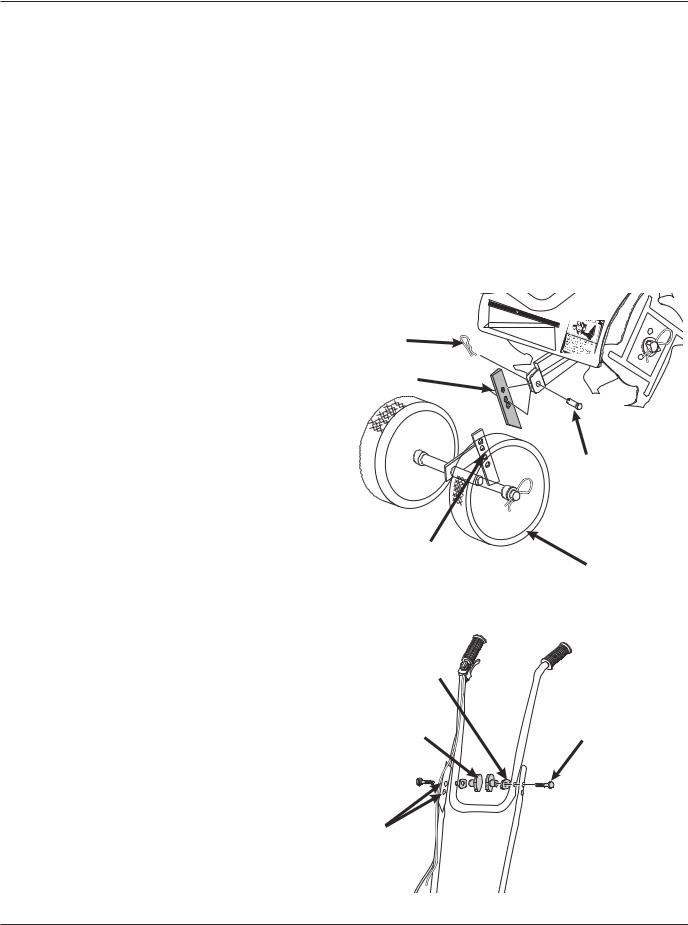
OPERATION
SAFETY PRECAUTIONS
Before operating the tiller for the first time, please review the IMPORTANT SAFETY INFORMATION (see page 4) and the chapter titled BEFORE OPERATION (see page 10).
Even if you have operated other tillers, take time to become familiar with the operation of this tiller’s controls and handling.
For your safety, avoid starting or operating the engine in an enclosed area, such as a garage. Your engine’s exhaust contains poisonous carbon monoxide gas which can collect rapidly in an enclosed area and cause illness or death.
If the tiller starts to shake or vibrate, stop the engine immediately. After the tiller tines have completely stopped, inspect them to determine the cause of the vibration. Sudden vibration is a sign of a hazardous problem, such as loose or damaged tilling tines (or tiller accessory), hidden objects in the soil, or the ground that is too hard to till. Do not operate the tiller until the problem is corrected.
Moving The Tiller
The tiller has transport wheels to allow easy maneuvering to and from the work area. There are four holes that the transport wheels can be set at. Select the hole that sets the handlebars at a height that provides comfortable tiller maneuvering.
Do not move the tiller with the engine running.
Before tilling, remove the transport wheels and install the drag bar.
Drag Bar Installation
1.Make sure the engine is OFF before installing the drag bar.
2.Remove the lock pin and the 5/16 x 7/8 inch clevis pin. Remove the wheel assembly.
3.Install the drag bar with the pointed edge of the drag bar towards the tiller tines using the
5/16 x 7/8 inch clevis pin and lock pin.
4.When your tilling job is completed, reinstall the transport wheels in the reverse order of removal.
LOCK PIN
DRAG BAR
TRANSPORT
CURVED
HANDLEBAR 
|
|
|
|
• |
READ |
THE |
|
|
|
|
|
|
|
|
|
|
|
|
|
||
|
|
|
|
• |
|
|
|
|
|
|
|
|
|
|
|
|
|
||||
|
|
|
• |
KNOW |
OWNER'S |
TO |
|
|
WARNING |
|
|
|
|
||||||||
|
|
• |
|
KEEP |
|
|
|
|
|
|
|
|
|||||||||
|
|
|
• |
|
|
|
ALLLOCATION |
|
|
|
AVOID |
SERIOUS |
|
|
|
|
|
||||
|
• |
|
SHUT |
|
ALLOW |
|
|
|
|
|
|
|
|
|
|
||||||
• |
|
|
KEEP |
|
|
|
|
DEVICES |
|
|
OF |
ALL |
|
INJURY |
|
|
|||||
|
|
KEEP |
|
|
ENGINECHILDREN ORAND |
|
BEFORE |
|
|
|
|||||||||||
• USE |
|
AWAYBYSTANDERSBEFORE |
|
|
SHIELDS |
CONTROLSOPERATION. |
. |
|
|||||||||||||
|
|
|
|
|
|
|
|
FROM |
AWAY |
|
|
|
|
|
|
||||||
YOU. EXTREME |
|
|
FROMMANUALLYUNINSTRUCTEDPLACE AND |
|
|
||||||||||||||||
|
|
|
|
|
|
|
|
|
CAUTIONROTATING |
|
|
|
|
ADULTS |
TOWORKING. |
|
|||||
|
|
|
|
|
|
|
|
|
|
|
|
PARTSMACHINEUNCLOGGING. |
|
|
|||||||
|
|
|
|
|
|
|
|
|
|
WHEN |
|
|
WHILE |
|
|
TINESOPERATE |
|
||||
|
|
|
|
|
|
|
|
|
|
|
|
REVERSING ENGINE |
|
|
OR |
|
|
||||
|
|
|
|
|
|
|
|
|
|
|
|
|
|
|
OR |
|
IS RUNNING MAKINGMACHINE. |
||||
|
|
|
|
|
|
|
|
|
|
|
|
|
|
|
|
PULLING THE . |
|
REPAIRS. |
|||
|
|
|
|
|
|
|
|
|
|
|
|
|
|
|
|
|
|
|
MACHINE |
TOWARDS |
|
|
|
|
|
|
|
|
|
|
|
|
|
|
|
|
|
|
|
|
|
|
|
5/16 x 7/8 in CLEVIS
TRANSPOR
5/16-18 X 1 1/2 in
Handlebar Adjustment
To adjust the handlebar height, remove the two handlebar knobs, 5/16-18 x 1 1/2 inch handlebar bolts, and curved washers. Move the upper handlebar hole to align with either the upper or lower holes in the lower handlebar assembly.
LOWER HANDLEBA  R
R
12 |
FG100 TILLER |

OPERATION
Starting The Engine
1. Move the engine switch to the ON position.
2.To start a cold engine, move the choke lever to the CLOSED ( ) position.
To restart a warm engine, leave the choke lever in the OPEN position.
3.To start a cold engine, or after refueling an engine that has run out of fuel, press the priming bulb repeatedly until fuel can be seen in the clear plastic fuel-return tube.
To restart a warm engine, it is not necessary to press the priming bulb.
4.Place your left hand on the carrying handle rubber grip and hold it firmly. Make sure your feet are away from the tiller tines. With your right hand, pull the starter grip lightly until you feel resistance, then pull briskly. Return the starter grip gently.
5.If the choke lever was moved to the
CLOSED ( ) position, gradually move it to the OPEN position as the engine warms up.
Allow the engine to warm up for a few minutes after starting the engine cold.
The tiller tines should not rotate with the engine idling. If there is rotation at idle, adjust the idle speed correctly before using the tiller (see page 24).
Stopping The Engine
1.Release the throttle lever.
2.Move the engine switch to the OFF position.
ENG. SW.
OFF ONOFF
CARRYING
OPEN 
CLOSE
ENG. SW.
OFF ONOFF
THROTTL
ENGINE
STARTER
FUEL-RETURN
PRIMING
 CHOKE
CHOKE
ENGINE
FG100 TILLER |
13 |

OPERATION
TILLER OPERATION
1.Install the drag bar (see page 12). Honda recommends using the drag bar when tilling. The tiller can be difficult to control without the drag bar installed.
2.Adjust the handlebar to a comfortable position (see page 12) (waist height for normal tilling operation).
3.Set the tilling depth by moving the drag bar up or down (see page 12).
The ideal height of the drag bar will depend on the type of soil being tilled, and soil conditions at the time of tilling. In general, however, the drag bar should be adjusted so that the tiller is tilted slightly backward.
4.Start the engine (see page 13).
5.Tilt the tiller back until the tines are off the ground. Squeeze the throttle lever to full speed position (lever tight against the grip).
6.Lower the front of the tiller until the tines begin to dig into the ground.
7.Lower the handle slightly so the front of the tiller is raised about 6 - 8°. To get the maximum advantage from the tiller, hold the tiller at this angle while you are tilling the ground.
HANDLEBARS
THROTTLE DRAG BAR |
6 - 8°
Handling Tips
•If the tiller tends to move forward rapidly, push down on the handlebars to allow the drag bar to penetrate the soil and slow the forward motion of the tiller. Continue to press down until the tiller tines have dug to a desired depth that allows easy tiller handling.
•If the tines dig in but the tiller will not move forward, ease up on the handlebars and move the handlebars from side-to-side. If the tiller still digs in, but will not move forward, raise the drag bar up a hole.
•When turning, push down on the handlebars to bring the tiller’s weight to the rear; this will make turning easier.
14 |
FG100 TILLER |
